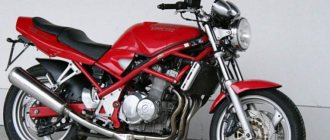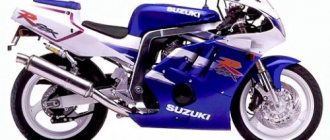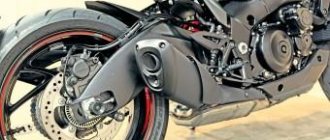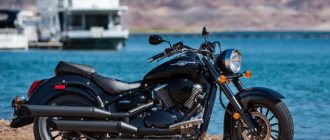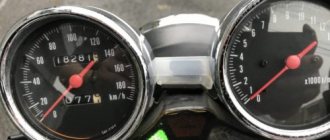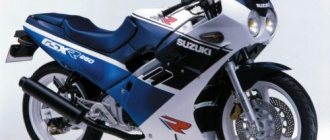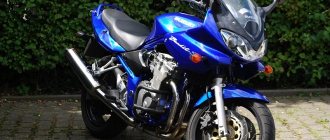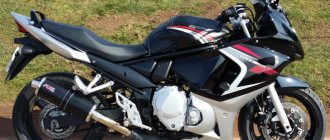| Suzuki GSX-R600 (1997-2000) | Suzuki GSX-R600 (2001-2003) | Suzuki GSX-R600 (2004-2005) |
| Suzuki GSX-R600 (2006-2007) | Suzuki GSX-R600 (2008-2010) | Suzuki GSX-R600 (2011+) |
Suzuki GSX-R 600 sports motorcycle model
first appeared in 1992. At that time, the model was a Suzuki GSX-R750 with a smaller engine without any changes. This model existed until 1993, after which it disappeared from the Suzuki motorcycle line.
The redesigned Suzuki GSX-R600 model was introduced in 1997, and it is with this model that the history of the model begins. Also based on the Suzuki GSX-R750, the new GSX-R 600 gets a new SRAD (Suzuki Ram Air Direct) engine and updated exterior styling.
The first major update of the model took place in 2001. The Suzuki GSX-R600 model receives a new, more modern design, electronic fuel injection instead of carburetors, and a new engine configuration (shorter crankshaft stroke, increased compression ratio). Maximum power increases from 106 to 118 hp.
In 2004, the model undergoes a new restyling, receiving an updated appearance, radial calipers, an inverted fork, a new generation of frame and engine - a 32-bit control unit, titanium valves, an increased compression ratio (from 12.2 to 12.5). Maximum engine power increases to 120 hp.
In 2006, the model was changed again, receiving a new appearance, a new exhaust system, new calipers, a slipper clutch and a slight optimization of the engine, which increased the maximum power to 121 hp.
For 2008, the Suzuki GSX-R600 is updated to the next generation, receiving a new exhaust (to meet new noise requirements), a new subframe and fuel tank. The motorcycle is also equipped with the S-DMS (SUZUKI Drive Mode Selector) system, which allows you to select one of three engine operation maps.
2011 was marked by another restyling of the model. Apart from the looks, the Suzuki GSX-R600 gets a new Showa BPF fork, Brembo monoblock calipers, lightweight frame and swingarm (total weight reduction - 9 kg). Maximum power increases to 125 hp.
Suzuki GSX-R600: electronic options
- S-DMS (SUZUKI Drive Mode Selector) - since 2008
The main competitors of the Suzuki GSX-R600 in the class
:
- Honda CBR600RR
- Kawasaki ZX-6R
- Yamaha R6
Brief history of the model
- 1997 - start of production and sales. First generation.
Model
: Suzuki GSX-R600 (Europe, North America, Australia).
Factory designation
: GSX-R600V.
- 1998 - no significant changes.
Model
: Suzuki GSX-R600 (Europe, North America, Australia).
Factory designation
: GSX-R600W.
- 1999 - no significant changes.
Model
: Suzuki GSX-R600 (Europe, North America, Australia).
Factory designation
: GSX-R600X.
- 2000 - no significant changes.
Model
: Suzuki GSX-R600 (Europe, North America, Australia).
Factory designation
: GSX-R600Y.
- 2001 - restyling of the model. Second generation.
Model
: Suzuki GSX-R600 (Europe, North America, Australia).
Factory designation
: GSX-R600K1.
- 2002 - no significant changes.
Model
: Suzuki GSX-R600 (Europe, North America, Australia).
Factory designation
: GSX-R600K2.
- 2003 - no significant changes.
Model
: Suzuki GSX-R600 (Europe, North America, Australia).
Factory designation
: GSX-R600K3.
- 2004 - restyling of the model. Third generation.
Model
: Suzuki GSX-R600 (Europe, North America, Australia).
Factory designation
: GSX-R600K4.
- 2005 - no significant changes.
Model
: Suzuki GSX-R600 (Europe, North America, Australia).
Factory designation
: GSX-R600K5.
- 2006 - restyling of the model. Fourth generation.
Model
: Suzuki GSX-R600 (Europe, North America, Australia).
Factory designation
: GSX-R600K6.
- 2007 - no significant changes.
Model
: Suzuki GSX-R600 (Europe, North America, Australia).
Factory designation
: GSX-R600K7.
- 2008 - restyling of the model. Fifth generation.
Model
: Suzuki GSX-R600 (Europe, North America, Australia).
Factory designation
: GSX-R600K8.
- 2009 - no significant changes.
Model
: Suzuki GSX-R600 (Europe, North America, Australia).
Factory designation
: GSX-R600K9.
- 2010 - no significant changes.
Model
: Suzuki GSX-R600 (Europe, North America, Australia).
Factory designation
: GSX-R600L0.
- 2011 - restyling of the model. Sixth generation.
Model
: Suzuki GSX-R600 (Europe, North America, Australia).
Factory designation
: GSX-R600L1.
- 2012 - no significant changes.
Model
: Suzuki GSX-R600 (Europe, North America, Australia).
Factory designation
: GSX-R600L2.
- 2013 - no significant changes.
Model
: Suzuki GSX-R600 (Europe, North America, Australia).
Factory designation
: GSX-R600L3.
- 2014 - no significant changes.
Model
: Suzuki GSX-R600 (Europe, North America, Australia).
Factory designation
: GSX-R600L4.
- 2015 - no significant changes.
Model
: Suzuki GSX-R600 (Europe, North America, Australia).
Factory designation
: GSX-R600L5.
- 2016 - no significant changes.
Model
: Suzuki GSX-R600 (Europe, North America, Australia).
Factory designation
: GSX-R600L6.
- 2017 - no significant changes.
Model
: Suzuki GSX-R600 (Europe, North America, Australia).
Factory designation
: GSX-R600L7.
- 2018 - no significant changes.
Model
: Suzuki GSX-R600 (Europe, North America, Australia).
Factory designation
: GSX-R600L8.
- 2019 - no significant changes.
Model
: Suzuki GSX-R600 (North America, Australia).
Factory designation
: GSX-R600L9.
- 2020 - no significant changes.
Model
: Suzuki GSX-R600 (North America, Australia).
Factory designation
: GSX-R600M0.
- 2021 - no significant changes.
Model
: Suzuki GSX-R600 + 100th Anniversary Edition (North America, Australia).
Factory designation
: GSX-R600M1 + GSX-R600ZM1.
- 2022 - no significant changes.
Model
: Suzuki GSX-R600 (North America, Australia).
Factory designation
: GSX-R600M2.
MY MOTORCYCLE
Twenty-nine years ago, in 1985, the first Suzuki GSX-R rolled out of the gates of the assembly complex of a Japanese motorcycle manufacturer, which was destined to change the world of motorcycles - and in 2012, Suzuki released its millionth “jixer”, it was one of the bikes of the special GSX series. R1000, a total of 1985 of these motorcycles were built.
The history of this model is quite eventful - of course, we won’t touch on everything. Let's talk only about the most intense ones, I hope you will learn something new about this fairly famous sportbike
The first Suzuki GSX-R750. Produced from 1985 to 1988
One of the main and at the same time revolutionary features that distinguishes it from its predecessors on the Suzuki GSX-R750 model, which made a splash at the 1984 Cologne Motor Show, was headlights. Then these sportbikes were even called “racing motorcycles equipped with lighting devices” for some time. Until this point, sports motorcycles were not intended for civilian use; they could not be ridden on the streets. But thanks to the headlights and mirrors - the GSX-R750 was above these rules - it broke stereotypes.
The engine of the first oil-air-cooled jixer produced almost 100 horsepower - much more than any of its competitors. However, an even more important feature of the motorcycle was its light weight - only 179 kilograms - at that time the closest competitor with an engine capacity of 750 cc weighed almost half a centner more. These advantages made the GSX-R750 an instant track star. In the 24-hour race of Le Mans in 1985, he took first and second places, a little later he won the brutal races on the Isle of Man. After such achievements, the bike immediately becomes a bestseller.
Suzuki GSX-R1100. Produced from 1986 to 1998.
A year later, the GSX-R1100 model entered the market. The older brother had a softer character - he knew how to forgive the rider’s mistakes and was more adapted to road conditions. The powerful, large-volume engine was not so demanding on precise gear shifting and had good traction in any speed range. Despite the “civilian” settings, sports technologies were widely used in the GSX-R1100 - in particular, a cartridge fork was installed on a motorcycle for the first time. The GSX-R1100's average lap times weren't much better than its little brother - but over time, the bike evolved into a great drag racing machine.
Suzuki GSX-R750 1988 model year. Produced from 1988 to 1992.
By 1988, the 750th jixer had undergone deep processing and received its first nickname - “slingshot”. Suzuki designers tried to maximize engine power in order to overtake competitors with liquid-cooled engines and created a 748 cc engine with a short piston stroke, a forced air intake and a fundamentally new carburetor design. One side of the carburetor's movable spool was flat, while the other was semicircular in the shape of a slingshot, which made it possible to create a high-quality fuel-air mixture. Thanks to this ingenious device, the motorcycle got such an unusual nickname.
The fairings received a new shape - they became more advanced in terms of aerodynamics, the wheelbase was the shortest among motorcycles in this class, the rigidity of the aluminum frame was increased by 60 percent, and in addition, the designers managed to increase the efficiency of the engine cooling system. Unfortunately, the new modification turned out to be heavier than its predecessor, but this drawback had almost no effect on the characteristics of the motorcycle - in 1988 it took first places in several world championships.
A year later, the GSX-R1100 was also upgraded for the first time. The designers increased its engine from 1052 to 1127 cc, strengthened the chassis, increased the diameter of the fork stays to 43 mm and for the first time installed 17-radius wheels on the bike.
Suzuki GSX-R750 1992 model year. Produced from 1992 to 1996.
In the 90s, Suzuki designers were faced with the need to change the engine cooling system to meet sporting standards. But it was decided not to completely abandon oil cooling - the existing circuit was simply supplemented with a liquid radiator and several pipes. Now the engine cylinders were cooled by oil supplied through special injectors under the heads, and the oil cooler, in turn, was cooled by water.
The new frame and swingarm are 24 percent stiffer than the previous model, and the top speed is 253 km/h. Over the next few years, the new motorcycle faced a difficult struggle for the title of the best with other Japanese and Italian brands, which began to actively develop the niche of sport bikes.
The first, unsuccessful version of the Suzuki GSX-R600. It was released over several months. Production ceased at the beginning of 1993
In 1992, the first GSX-R600 appeared, however, it turned out to be so unsuccessful that later the company’s management decided not to remember it - Suzuki’s official website indicated a different date of birth of the model. Essentially, the first GSX-R600s were 750s with a stripped-down engine. They were heavy, slow and clumsy. There are very few copies of these motorcycles left in the world, as the company quickly decided to curtail their production.
Suzuki GSX-R750 1996 model year. Produced from 1996 to the present in various modifications
In 1996, the updated 750 series jixer was released, the distinctive feature of which was the new SRAD inertial supercharging. The designers finally replaced the double open frame with a more rigid spar frame made of aluminum, the piston stroke was reduced to 46 mm, and the liquid-cooled engine with two camshafts was equipped with the above-mentioned SRAD system, the purpose of which is to pump air into the intake manifold (the system “has caught on” and used on all Suzuki sportbikes to this day). It should be noted that by the mid-90s, the jixer had already completely lost the aura of a pioneer and winner. It was the updated GXS-R750 model that managed to improve its reputation, which became the main prize-winner of the world endurance championships in 1997, 1999 and 2000.
Suzuki GSX-R600 1997 model year. Produced from 1997 to the present in various modifications
The little brother in the GSX-R600 family made its debut in 1997 to compete in the new Supersport racing category. However, calling this motorcycle junior can only be a stretch - it is only 5 kilograms lighter than the GSX-R750, and in terms of characteristics it was even ahead of its relatives - its piston stroke height was only 44 and a half millimeters, and the compression was 12.0: 1. While working on the body of the new bike, the designers tested it several times in the wind tunnel and as a result achieved a minimum air resistance coefficient. The new model won races the following year, when Fabrizio Pirovano took first place in the Supersport championship.
Suzuki GSX-R1000 is the first liter jixer. Produced from 2001 to present
By 2001, the Suzuki GSX-R600 was already being produced with a new frame and engine, which was equipped with fuel injection for the first time. But the real highlight of this year was the premiere of the GSX-R1000. Despite the large 988cc engine and reinforced frame, this bike was only 4.5 kilograms heavier than the 750 model. In addition to injectors, its engine had two throttle valves, and the braking system was introduced for the first time with six-piston calipers. The newcomer immediately became the winner of the World Endurance Championship and the Japanese Championship.
In 2001, the rules of motorcycle racing underwent significant changes, due to which sportbikes with an engine capacity of 750 cc were actually left behind. As a result, all manufacturers except Suzuki stopped producing such models. The GSX-R750 is still rolling off the production line.
Suzuki GSX-R1000 2005 model year
By 2005, the GSX-R1000 was considered by many to be the best sportbike of all time. This year's model once again lost weight, winning the title of the lightest motorcycle in this class. But at the same time, its engine became stronger, engine displacement increased from 988 to 999 cc, a slipper clutch appeared, and the body and fairing took on a new, more aerodynamic shape. The following year, the 600th and 750th jixers were updated. The designers managed to make their motors smaller - this allowed them to be placed on the frame in such a way as to achieve an ideal weight balance. Also, thanks to the smaller engines, the length of the pendulum arm has increased - as a result, the motorcycle has become more stable, although the wheelbase remains the same.
Suzuki GSX-R1000 2007 model year
Due to increasingly stringent environmental requirements, the 2007 GSX-R1000 gained a couple of kilos in weight - a second muffler and a larger exhaust manifold were installed on the bike. However, this increase was offset by a long list of improvements, which included forged aluminum pistons, hollow camshafts, titanium valves, iridium spark plugs and a widened air intake. The 2007 liter jixer also featured the ability to electronically switch engine operating modes for the first time.
Latest model Suzuki 2011 GSX-R600. Serial production began in 2011
The current generation of GSX-R600 and GSX-R750 appeared in 2011, when Suzuki designers focused on increasing efficiency, reducing weight and improving the chassis. Thanks to these efforts, in particular, reduced mechanical energy losses and improved crankcase ventilation, today's jixer engines perform better in the low and medium speed ranges. In addition, the motorcycles “shed” about 10 kilos, received Showa forks and Brembo calipers, providing excellent handling and brakes. And although these motorcycles have not won any serious sports trophies, many consider them to be the best representatives in their classes.
Suzuki GSX-R1000. Produced since 2012
The latest generation of liter jixers debuted at a difficult time for Suzuki - a period of financial problems for the company and the entry of European competitors into the market. The motorcycle no longer has the aura of triumph surrounding it like its predecessors, but it is still a contender to be reckoned with. Many new technologies that were previously used on the 600 and 750 models migrated to this bike - a ventilated crankcase, lightweight pistons, increased compression. The GSX-R1000 has once again been lightened - this time by a little more than two kilograms - new technologies have eliminated the need for a second exhaust pipe and a larger exhaust manifold, and the bike's brake discs are clutched by lightweight Brembo calipers.
For 29 years, jixers have collected all the prizes several times at all famous competitions and championships. Both 600cc, 750 and liter jixers have their fans in all countries of the world. You can meet them everywhere. And let’s hope that everything will be fine for Suzuki and they will delight their fans with new products in the world of motorcycles. And not only jixers - other bike models too.
Specifications
Technical characteristics of Suzuki GSX-R600:
| Model | Suzuki GSX-R600 |
| Motorcycle type | sports |
| Year of issue | 1997+ |
| Frame | aluminum |
| engine's type | 4-cylinder, 4-stroke, in-line |
| Working volume | 600 cm³ – GSX-R600 (1997-2000) 599 cm³ – GSX-R600 (2001+) |
| Bore/Stroke | 65.5 x 44.5 mm – GSX-R600 (1997-2000) 67.0 x 42.5 mm – GSX-R600 (2001+) |
| Compression ratio | 12.0:1 – GSX-R600 (1997-2000) 12.2:1 – GSX-R600 (2001-2003) 12.5:1 – GSX-R600 (2004-2007) 12.8:1 – GSX-R600 (2008-2010) 12.9:1 – GSX-R600 (2011+) |
| Cooling | liquid |
| Number of valves per cylinder | DOHC, 4 valves per cylinder |
| Fuel supply system | Carburetor, 4x Mikuni BDSR36 – GSX-R600 (1997-2000) Injector, 4x – GSX-R600 (2001+) |
| Ignition type | transistor |
| Maximum power | 106.0 hp (78.0 kW) at 12000 rpm – GSX-R600 (1997-2000) 118.0 hp (86.7 kW) – GSX-R600 (2001-2003) 120.0 hp (88.2 kW) at 13000 rpm – GSX-R600 (2004-2005) 121.0 hp (89.0 kW) at 12400 rpm – GSX-R600 (2006-2007) 125.0 hp (91.9 kW) at 13500 rpm – GSX-R600 (2008+) + S-DMS (SUZUKI Drive Mode Selector) – GSX-R600 (2008+) |
| Maximum torque | 66.0 Nm (6.7 kg*m) at 10,000 rpm – GSX-R600 (1997-2000) 70.0 Nm (7.1 kg*m) at 10800 rpm – GSX-R600 (2004-2005) 68.0 Nm (6.9 kg*m) at 11500 rpm – GSX-R600 (2006-2007) |
| Clutch | Multi-disc in oil bath, cable drive |
| Transmission | 6-speed |
| type of drive | chain |
| Front tire size | 120/70-ZR17 (58W) |
| Rear tire size | 180/55-ZR17 (73W) |
| Front brakes | 2 discs, 310 mm, 4-piston calipers – GSX-R600 (1997-2003) 2 discs, 310 mm, 4-piston radial calipers - GSX-R600 (2004-2010) 2 discs, 310 mm, 4-piston Brembo radial monoblock calipers – GSX-R600 (2011+) |
| Rear brakes | 1 disc, 220 mm, 2-piston caliper |
| Front suspension | Telescopic fork (fully adjustable), travel - 120 mm - GSX-R600 (1997-2003) Inverted fork (fully adjustable), 120mm travel – GSX-R600 (2004-2010) Showa BPF inverted fork (fully adjustable), 120mm travel – GSX-R600 (2011+) |
| Rear suspension | Pendulum with monoshock absorber (fully adjustable) |
| Motorcycle length | 2065 mm – GSX-R600 (1997-2000) 2040 mm – GSX-R600 (2001-2003, 2006-2010) 2055 mm – GSX-R600 (2004-2005) 2030 mm – GSX-R600 (2011+) |
| Motorcycle width | 720 mm – GSX-R600 (1997-2000) 715 mm – GSX-R600 (2001-2010) 710 mm – GSX-R600 (2011+) |
| Motorcycle height | 1135 mm – GSX-R600 (1997-2003, 2011+) 1150 mm – GSX-R600 (2004-2005) 1125 mm – GSX-R600 (2006-2010) |
| Wheelbase | 1390 mm – GSX-R600 (1997-2000) 1410 mm – GSX-R600 (2001-2003) 1400 mm – GSX-R600 (2004-2010) 1385 mm – GSX-R600 (2011+) |
| Seat height | 830 mm – GSX-R600 (1997-2003) 825 mm – GSX-R600 (2004-2005) 810 mm – GSX-R600 (2006+) |
| Minimum ground clearance (clearance) | 130 mm – GSX-R600 (1997-2003, 2006+) 135 mm – GSX-R600 (2004-2005) |
| Acceleration 0-100 km/h (0-60 mph) | 3.02 sec[1] |
| Maximum speed | 251 km/h[2] |
| Gas tank capacity | 18.0 L – GSX-R600 (1997-2003) 17.0 L – GSX-R600 (2004-2005, 2008+) 16.5 l – GSX-R600 (2006-2007) |
| Motorcycle weight (dry) | 174 kg – GSX-R600 (1997-2000) 164 kg – GSX-R600 (2001-2003) 161 kg – GSX-R600 (2004-2007) 165 kg – GSX-R600 (2008-2010) |
| Motorcycle weight (curb) | 187 kg – GSX-R600 (2011+) |
"Jixer." How much of this word…
The formidable nickname “jixer”, due to its coolness and brutality (moreover, justified), is firmly entrenched in the first lines of the hit parade of motorcycle words, plunging people in the subject into awe and ecstasy. The only thing cooler is the phrase “liter jixer.”
Suzuki specialists have always had their own special view on the production of motorcycles, especially sports bikes - each GSX - R was created in order to become the best sports motorcycle of its time. The G SX - R 1000 family once again confirms this. “Liter” in the model line, which by that time already included five different engine displacement options (250, 400, 600, 750, 1100), appeared later than everyone else and immediately made a splash in the camp of competitors.
First generation (2001–2002 K 1- K 2)
In 2001, the first generation of Suzuki GSX - R 1000 K 1 - was released - the starting point for future champion sportbikes. Index K 1, 2, 3, 4... etc. indicates the model year of a particular motorcycle, the starting point is 2001. The newcomer immediately received the title of “motorcycle of the year” in the ratings of 13 authoritative motorcycle publications around the world.
Taking the GSX - R 1100 and GSX - R 750 as a basis, the engineers did a lot of work, the result of which was a new engine, not made from scratch (but, nevertheless, fraught with unprecedented aggression and technology), and a retuned chassis . 750 cubic centimeters turned into 998 by increasing the cylinder diameter by 1 mm and the piston stroke by 13 mm, the pistons themselves are ultra-light forged low friction (minus 3 grams from the weight of each compared to the GSX - R 750). The clutch basket, gearbox ratios, and oil cooling system have changed. The cylinder walls are coated with a nickel-phosphorus-silicon-carbon composite instead of liners, the camshafts are hollow, four-valve cylinder heads, and a balancer shaft. A big step forward is a clever fuel injection system with two valves per cylinder, simulating the operation of a constant vacuum carburetor. The competitiveness of the Yamaha YZF - R 1 1998 became a big question mark; it turned out to be less powerful and heavier.
The GSX - R 1000 K 1 is exactly like the GSX - R 750 from 2000-2001. Motorcycles really have a lot in common, the differences are concentrated in the units that take on the increased load - the “liter” frame has increased torsional rigidity by 10% (due to thickening the walls by 0.5 mm), the engine has grown in volume by 15 mm higher and 6 mm longer, the wheelbase is completely identical, the length, width and reach are approximately the same.
As a result of all the transformations, the new king of racing tracks, to the envy of his competitors, turned out to be surprisingly lean - 4.5 kg heavier than the Suzuki GSX - R 750 2001. and 1 kg heavier than the Yamaha YZF - R 6 2000.
The 4-2-1 exhaust system is unique in its own way - to reduce weight, its elements are made of a combination of titanium, steel and aluminum, and inside is a Suzuki Exhaust Tuning (SET) valve, controlled electronically. Its main task is to regulate back pressure. At low speeds the valve closes, which increases torque and reduces noise.
They didn’t spare money on a good chassis: a steering damper, a 43 mm “inverted” shock absorber at the front and a monoshock absorber at the rear with a full range of adjustments. It is worth noting that professionals note some “stubbornness” when turning the motorcycle into turns. Effective braking is provided by massive floating six-piston calipers at the front and two-piston at the rear; the front brake discs are huge - 320 mm.
In 2002, there were some minor changes aimed at improving the overall balance of the design - the mirrors and luggage hooks were upgraded, and new colors appeared. All together did not affect the weight of the motorcycle. It is not difficult to distinguish K 2 from K 1; in the latter, the exhaust system elbow preceding the muffler can is painted black, and the middle part (with the Exup valve) is made of titanium.
Due to their friendliness and relative comfort for the pilot (compared to all subsequent generations), the K 1 and K 2 are frequent guests on the secondary market; spare parts and tuning parts are on sale in large quantities. Stuntriders rightfully respect first-generation motorcycles for their indestructibility and maintainability.
Second generation (2003–2004 K 3- K 4)
In 2003, Suzuki refined its flagship sportbike, making it lighter, faster, more powerful and more controllable. Dry numbers (minus 2 kilograms of weight and plus 2 horsepower) do not fully reflect the nature of the changes made.
They decided not to touch the engine displacement for now; the improvement in power, torque and response speed to turning the throttle is the result of painstaking tuning and the use of the latest technologies. By introducing additional ventilation windows between adjacent cylinders, it was possible to reduce losses due to air compression under the pistons; it now flows from a high-pressure zone to a low-pressure zone. The power of the engine control system has been increased from 16 to 32 bits. Each cylinder now has two ignition timing change maps (one at low load, the other at maximum). The transformations brought an additional 2 liters. With. and 10 Nm.
Owners of K 1 and K 2 often complained about the explosive and uncontrollable reaction of the engine to turning the throttle, to which the Japanese responded by installing the Suzuki Dual Throttle Valve (SDTV) system (two throttle valves, one of which reacts to the actions of the pilot, the second - the CPU ) - thus the wayward character was curbed.
With a significantly redesigned frame (structural elements are connected using extrusion, ribs with “programmed” rigidity, painted black), the geometry of the motorcycle has not changed, the length and width indicators are identical to the previous generation motorcycle. Additional changes include a redesigned rear subframe that bolts to the frame and an adjustable rear swingarm mount that allows for changes in chassis geometry.
Suzuki, under the pretext of reducing overall weight, decided to abandon the six-piston floating front calipers in favor of four-piston radial-mounted ones and a reduced diameter of the front brake discs from 320 mm to 300 mm. The main reason is the 300 grams of weight saved.
The appearance of the K 3 is optimized to improve aerodynamics and weight distribution - a vertically positioned headlight made it possible to narrow the head plastic and place the inertial boost pipes closer to the center line (in this place the highest air flow pressure), the rear light was equipped with LEDs, a lightweight titanium exhaust system saved 600 grams weight, the dashboard received a blinker. To provide the driver with more freedom while driving the motorcycle, the gas tank was narrowed in the seat area.
In 2004, a couple of innovations appeared in the design of the GSX - R 1000 K 4, which became standard for all subsequent generations - now on the gas tank, instead of the inscription “Suzuki”, there is a modified company logo in the form of a convex letter S, and the brake calipers, although externally similar, became two-pad (four small pads for each caliper).
Several livery color schemes have been added compared to the previous release year, including the Mat Mladin Championship Replica Edition.
An interesting fact: the first two generations, despite all their merits and regalia, were distinguished by very mediocre control; in order to sharply change the trajectory of movement at a decent speed, it was necessary to have remarkable physical strength. At K3-K4 we ran out of truly indestructible liter “jixers”.
Third generation (2005–2006 K 5- K 6)
The main emphasis in the development of the next generation is the modernization of the chassis and engine. The list of innovations is significant - a redesigned cylinder head, an increased cylinder diameter, intake and exhaust valves are now made of titanium alloy (the intake valves have increased in diameter), even lighter pistons, an increased compression ratio, thinner connecting rods and crankshaft, closer gearbox ratios , reconfigured Suzuki Dual Throttle Valve System, the fuel injection system was improved again - starting from the K5, they began to install two injectors per cylinder, the throttle valves were increased from 42 mm to 44 mm, a reverse torque damper appeared in the clutch basket (to reduce engine braking when the "gas"), in addition, we again went through an audit of the exhaust system. Many noted that the K 5 pleasantly differs from other varieties with good traction in the mid-speed range. The result of the engineers' work resulted in a weight reduction of 2 kg, an increase in the volume of the combustion chamber and an increase in power.
The K 5 and K 6 decreased in almost all geometric dimensions compared to previous generations and began to stubbornly resemble the GSX - R 600 in terms of chassis (the entire chassis was updated - wheels, frame, suspension). “Jixer riders” who are switching to third-generation motorcycles, one and all, noted a tighter and less relaxed driving position. Take a look for yourself - the distance from the seat to the handlebars has been reduced (mainly due to a shorter gas tank), the driver's footrests have been lowered along with a 20 mm reduction in the height of the saddle.
Cosmetic changes are noticeable to the naked eye; it is not so easy to confuse K 5 with K 1 or K 3. The air ducts of the inertial charging system, separated into a separate section, now compress the headlight even more tightly, which has become narrower and shaped like a bird with outstretched wings. The side plastic is losing ground and is losing size and thickness generation by generation. The tail unit has transformed from a long “shovel” into a complex polygon with a large number of edges. The turn indicators have moved to the rearview mirrors once and for all. There wasn’t much room for a passenger on the Jixers before, but now it’s so difficult to select the only one whose backside matches the size of the passenger pillow!
The frame of the motorcycle was reprofiled in such a way as to concentrate the center of mass as low as possible and closer to the centerline, due to this it became slightly less resistant to impacts. There is a certain series of VIN numbers that are susceptible to seam cracks, Suzuki even released a reinforcement kit to take some of the stress off the frame. The lightweight rear swingarm is designed to allow the exhaust pipe to be retracted as much as possible, thereby improving mass centralization. The braking system also did not go unnoticed - the front discs increased to 310 mm, and a radial brake cylinder with a 19 mm piston was installed on the steering wheel.
In the second year of production, the third generation of Suzuki GSX - R 1000 has traditionally limited itself to only updating the motorcycle’s colors.
Fourth generation (2007–2008 K 7-K 
The fourth reincarnation of the legendary “Jixer”, having greatly increased power, added centimeters in length, width and wheelbase and acquired 6 kilograms of excess weight.
The appearance did not change so dramatically; the engineers did not deviate from the general concept. There is even less side plastic left, the headlight has parted with sweeping wings, and in contrast to this, two monstrous exhaust pipes have opened up on the sides, which only the lazy would not deplore. The manufacturer explains this move by stricter environmental standards and better weight distribution of the device.
They again worked hard on the engine - the fuel injection system was reconfigured, the ventilation holes between the cylinders increased to 48 mm, but the main innovation is the updated engine management system, which, in addition to allowing for an increase in power, also has three switchable modes. As an experiment, a hydraulic one was mounted in place of the mechanical clutch drive. Conceptually, the architecture of the K 1-K 8 engines is similar, many parts are interchangeable.
The frame and subframe have once again been lightened and strengthened (the location of the seams has changed, and a gusset has been added under the vertical seam near the steering column), the updated front fork now provides 125 mm of wheel travel, and a new electronically adjustable damper has improved the directional stability of the motorcycle. The motorcycle has lost the excessive agility of the K 5 and acquired the necessary stability on the trajectory. Starting with the K 7 and all subsequent generations, a single-piston caliper was installed at the rear.
There are black spots in the biography of the Suzuki GSX - R 1000 K 7. The idle speed sensor was sick from birth, so it worked every other time, as a result, the motorcycle sometimes started at high speeds, the problem was solved by a global recall campaign.
Suzuki GSX - R 1000 K 8 again differs from the prototype only in coloring.
Interesting facts: up to the fourth generation inclusive, the bulk of the criticism from owners relates to the brake system - the aluminum pistons in the calipers quickly overheat and lose efficiency. A common solution to the problem is to install calipers from Yamaha YZF - R 1.
Fifth generation (2009–2011 K 9-K 11)
By 2009, the developers had prepared a motorcycle with significant changes in appearance and features.
Consider the flashy appearance with sharp cheekbones and the winged headlight that has once again taken its place. The serious torso is supported by no less impressive exhaust pipes (even more massive, which will not be reflected in the best way during falls). The engineers practically built an even more revving engine from scratch, mounted it all on an inverted BPF (big piston fork) telescopic fork and equipped it with new monoblock brakes; the motorcycle did not see the expected ABS and traction control.
New engine, oddly enough. develops exactly the same power as before. The clutch is again mechanical; according to the manufacturer, such a drive is still preferable in racing conditions, it is lighter and more precise. The engine power mode switching unit was inherited from the K 7 (now it is located on the left clip-on).
When designing the chassis, the task was to combine the good handling of the K 5 and the stability of the K 7. To do this, it was necessary to lengthen the rear swingarm, but at the same time reduce the wheelbase to 1405 mm. The front fork with enlarged pistons, coupled with updated monoblock front calipers with a changed diameter of the main brake cylinder (from 19 mm to 17.5 mm) work effectively in tandem, but the braking dynamics must still be recognized as not corresponding to the engine’s potential.
Sixth generation (2012–2013 K 12- K 13)
Hopes that in 2012 a completely new revolutionary “jixer” would see the light of day were not destined to come true. Suzuki GSX - R 1000 K 12 was just a work in progress.
New 11% lighter pistons and an increase in compression ratio to 12.9 resulted in an increase in mid-range power, which in turn slightly improved acceleration and fuel efficiency. The weight of the motorcycle was reduced by 2 kilograms as a result of the abandonment of two exhaust pipes in favor of one, as well as the installation of thinner brake discs, a shorter front fork and a lighter front tire. A royal gift to lovers of the brand are Brembo monoblock brake calipers.
There are few stylistic changes with the exception of the exhaust pipe - new graphics, red stripes on the plastic and wheels.
Conclusion
The Jixer was and remains an icon of style and power among fanatical fans of extreme speed. Even having been delayed in his development and let the more nimble “Europeans” get ahead, he is still the personification of risk, courage and recklessness.
Fuse > 27 April 2013 13:51 Mikhail Pimus
Reviews
Reviews about Suzuki GSX-R600:
Expand Collapse
The control is excellent, the acceleration is simply a bomb, even a subaru wrx sti at a traffic light was able to get me 2-3 body breaks away at once!!! It’s very comfortable to sit on it, even though I’m not small and have a potbelly))))))) But I immediately say swing your forearm into the trash of your hand and your forearm flows into the trash and you immediately don’t have fingers, but just some kind of curls. But after riding for 2 days everything went away. On the first day, I rode 300 km with several stops to drink and pee, I just didn’t notice how it was already night and in 300 km it ate almost the entire tank.
I decided to try what he could show me, sat down and began to unscrew, but not to the red zone, but somewhere up to 9000 rpm. In short, after a few seconds I was already driving it at 230 km/h, but I couldn’t accelerate any further, the heavy traffic started and I had to slow down. About the brakes, everything was clear, smoothly, evenly, without jerking, the brakes pleased me. It takes turns clearly, as if it were an extremely accurate model of the continuation of my body and tailored purely for me!!!
The guy just doesn’t like bad roads, he goes over potholes easily, but in general the bumps are a pain, you ride like you’re riding a horse, on the pegs. Although I adjusted the suspension to be soft. Maybe my weight of 60 kg is not enough for him. Engine . Before the season I changed all the consumables, and it makes me happy. It doesn’t consume oil at all, the gasoline consumption is 6 liters, if you light it too hard for 200, I think it’s 9 liters. The oil is Motul 7100. The dynamics are good, the sound too, the maximum speed is about 262 km per hour, I think it’s very good for such a mileage. Wind protection is normal, in the rain it wets your feet and shoulders along with your head and arms. Summary: A good motorcycle for aggressive driving on good roads, I consider it reliable, but I do not recommend it at all for beginners, I think it will forgive very few mistakes.
An incredible SPORTS motorcycle, beautiful in design and performance.
Let's talk about the advantages right away:
Of course, this is a driving motorcycle, if you want the motorcycle to fly out from under your ass when you open the throttle, then this is exactly what you need. This is a oh so sporty insanely fast and heartbreaking motorcycle. I did not have any problems or questions regarding the correctness of its work. With proper care and proper care, it will respond to you in kind :) BUT there is one “but”
It lies in the fact that this is a SPORTS motorcycle and it is useless in daily use; if you are not going to use it for its intended purpose, that is, riding on a track, then it is better not to even think about buying it.
This is a provocateur bike :)) if you want to show off and show off in front of the girls, find yourself some beautiful road bike. It will cost less (especially in maintenance) and will be much MORE USEFUL AND CONVENIENT.
As for speed, this factor will NOT be enough for you on any solid-sized motorcycle.
Thank you for your attention:)
Even bikers envy the owner of the Suzuki GSX-R 600 K7 motorcycle, Mikhail.
Share
Tell
Share
Tweet
Share
When Mikhail and I agreed on a meeting and agreed to be there in 20 minutes, he said: “Well then, I’ll leave in... 20 minutes.” And he arrived without delay. This is a mathematical paradox. The Suzuki GSX-R 600 K7 turns out to give an advantage in both speed and time.
“This is a motorcycle from 2007,” Mikhail recalls. — And I bought it three years ago in Belarus. I brought it in February, started it in the garage and thought: “HOW am I going to drive it?! Such power! Engine 600 cc cm, 132 l. s., 4 cylinders. It is absolutely impossible to maintain 2000 rpm. You turn the knob and it immediately gives out 3000-4000. Now I understand that this is not the limit. A couple of days ago I bought the same jixer from a friend, only 1000 cc. cm and 164 l. With. After that I sat down on my own and realized that there was something to strive for.
Suzuki GSX-R 600 K7 is a copy of a racing motorcycle adapted for the city. The maximum speed according to the passport is 274 km/h. Accelerates to 100 km/h in approximately 3.1 seconds, to 200 km/h in 7 seconds.
“My sports bike is technically better developed than the same liter jixer produced in 2004,” Mikhail is sure. “And it’s also much more comfortable.” There is a special clutch system installed here - the motorcycle does not lift up onto the rear wheel. I can be calmer for passengers. And many bikers envy me because this model has a special window that indicates the gear. When you ride another motorcycle, you are always trying to guess: third... fourth? And I can see it right away. I drive fast but carefully. I will never accelerate where it is not worth doing. At the age of 19 I bought my first motorcycle and then dreamed of a speed of 200 km/h. And now I understand that after 190 there is no difference in sensations. Only the braking is longer. And it's not so interesting to me anymore.
The first season is often the most difficult test for motorcyclists. Beginners, as usual, are involved in most accidents.
— It’s easy to pass your license. It’s more difficult to learn to drive,” Mikhail shares his experience. — We must remember that buying a motorcycle is not only entertainment. In my first season, I had an accident: my body was simply crushed on the asphalt. If I had been in my gear, nothing would have happened: I stood up and dusted myself off. From my own experience I was convinced that it is necessary to wear it. For beginners, it is better to start with 250 or 400, and then move on to 600 cc. see. You will have to search, sell and buy several times, but you should not skimp on your own safety.
Mikhail is much more interested in stunt riding. This is stunt motorcycle riding. But for this the bike needs special preparation. And it’s a pity to bend and break the plastic on the GSX-R 600 K7 during training. Replacing parts will cost a lot of money.
“I didn’t participate in races, I only raced at the karting track,” says Mikhail. — By the way, I learned a lot about my bike then. For example, at a speed of 10-15 km/h, the jixer can be tilted so that it lies on its side and is supported by wheels. Stunts help you gain driving experience and understand the capabilities of a motorcycle. I dreamed about this bike, now I’m saving it and don’t risk using it for stunt riding. When I bought the jixer, I only changed the color (it was black). There were a lot of ideas: I wanted to make a huge shark mouth or decorate it with comics. But experts said that the drawing may come out deformed. So I just decided to wrap the bike in white vinyl. The discs remained black. Yes, I also did some backlighting. There's only one button left to screw in, but I still can't finish it. So the motorcycle is only filled with diodes for now, and will start to glow later.
Mikhail also wants to install a DVR on his motorcycle. He is not going to interfere in the eternal confrontation with motorists, because there are enough reckless drivers and rule violators in both camps. But it’s still better to record what’s happening on our roads.
“Motorists may not pay attention to us at all,” says Mikhail. - But this, of course, depends on people. My motorcycle was recently “densed” by collectors in the parking lot. They backed up and got shot down. They said they just didn't see it. This was the third time in three years. But the worst thing comes not from people, but from road repairs. Two wheels fell off during the season. One is in the pit, the other is already on new asphalt. The “masters” left a step between the old and new sections.
Buying a car is in Mikhail’s plans, but only in the future. For now, the GSX-R 600 K7 is the most convenient form of transport for him.
— Jixer is stylish and lightweight: its weight is approximately 170 kg. This is a sports bike and is not intended for carrying luggage. But if you don’t drag suitcases with you, you can travel on it. I only drove it to St. Petersburg, but I could easily get to Moscow. Of course, you will need a car, because in rain and hail, and especially with a large group of friends or family, you cannot ride a motorcycle. But that comes later. And a motorcycle is for the soul and forever. This is freedom, and there is no way without freedom.
The Suzuki GSX-R, commonly called the Gixxer, is one of the most iconic sports bikes ever made!
Win on Sunday, sell on Monday. This is the sales strategy of car and motorcycle manufacturers. And Suzuki was the first sportbike manufacturer to successfully bring this strategy to the mass market. In 1985, they illuminated their race-winning 750cc SBK bike and offered it to the public, and Jixer was born. Over the years it has evolved into several different sizes and classes and has become a brand within a brand with many loyal fans around the world. Suzuki are back in the winner's circle in 2021, winning the MotoGP World Championship for the first time in their history, and once again they have made the most of it by providing buyers with a wide range of sports bikes in the Ecstar team colours.
1987 Suzuki GSX-R 750
Motorcycle for beginners
While most of us associate the GSX-R nameplate with pure performance machines, it technically started out as a beginner's sports bike in Japan as the GSX-R 400.
However, attention quickly shifted to the 750 as it had a racing pedigree and Suzuki made little effort to bring its race bike back to the street. They sold well and started a dynasty.
1984 Suzuki GSX-R 400
Gixxer means fast
Well, that's how it was for a while. The name has always been closely associated with the racing team, and this seemingly innocuous nickname meant a lot.
Suzuki has spent little time expanding its GSX-R lineup. The next step up to the 1100 was the 600. Models came and went, but today you can get a Gixxer in almost any displacement, from 150cc to 1000cc.
1989 Suzuki GSX-R1100
Track bikes for the street
After the hugely successful GSX-R 750 of the late '80s, Suzuki had to move with the times and modernize its machine accordingly in the early '90s.
However, even with their upgrades, Honda blew past them with their first 900cc Fireblade and they had to come up with a response.
SRAD system
By the mid-90s, the Suzuki Ram Air Direct (SRAD) system was introduced and revolutionized the intake system. Air enters through two openings located on either side of the front fairing and passes through sealed tubes directly to the filter. As the speed of the vehicle increases, the air speed also increases, and it puts more pressure on the filter. This allows the engine to develop maximum power at high speeds.
Their intakes added enough horsepower to beat Honda for a while, but by the end of the 90s, Honda was the least of their problems.
Middle class 600
For years, the 600 class served as something of an introduction to the sportbike class, and Suzuki has largely abandoned it.
Other manufacturers took advantage of this as the appetite for performance-oriented middleweights grew, Suzuki needed its 600 back. They came up with an all-new 600, equipped with the SRAD system that was first used in their 750, and the performance was more than enough to take on the competition.
Suzuki GSX-R 600
GSX-R1300
Now that Yamaha R1 is cutting sales of their 750 class bike, they knew they needed a liter bike but decided to use the pistol for knife fighting first.
Instead of releasing their liter bike right away, they distracted everyone by launching the GSX-R1300, also known as the Hayabusa. A sport-tour motorcycle that has been produced since 1999. It immediately won the title of “the fastest production motorcycle in the world” with a top speed of 303-312 km/h.
The Legend of K5
Although Suzuki were a bit of a latecomer to the liter bike class, they remained stable for the first few years of production, but a radical redesign changed all that.
For 2005, the Gixxer received a new engine and frame that saved weight, increased power, torsional rigidity and overall performance. It was unparalleled at the time, and even today the K5 competes with more powerful modern bikes.
35 years of GSX-R 750
With every other manufacturer ditching their mid-weight inline-four sportbikes, Suzuki is one of the few that is pushing ahead.
Last year, the 750 celebrated 35 years on the market and 10 years in its current form. It's still a very durable bike with proven performance both on and off the track. The latest version's engine outputs 127.9 hp at the rear wheel. (95.4 kW) at 12,600 rpm. Torque at the rear wheel is 75.5 Nm at 11,100 rpm. Wet weight is 194.1 kg.
2021 Suzuki GSX-R 750
Available Performance
Suzuki has made a name for itself over the years by offering more performance for less money. They are very proud of it.
Today their new prices remain competitive, but the only truly modern Gixxer is the 1000, with other bikes running on much older platforms to keep costs down.
2007 Suzuki GSX-R 1000
On the secondary market
Getting a new Gixxer may not be your first option. With such a large market for used superbikes and exceptionally reliable chassis, there are plenty of bargains to be had. Parts are cheap and there is a wide range of accessories to choose from for any model of any year.
Share with friends
